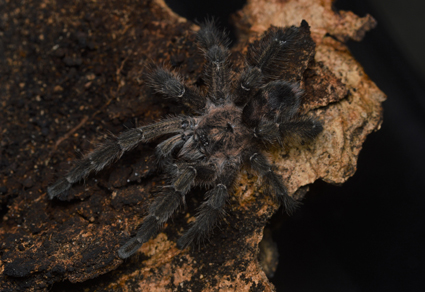Abstract
Theraphosidae is the most speciose mygalomorph family, and its species are usually fossorial, but arboreal species are known in various subfamilies. One of these subfamilies, Aviculariinae, is composed exclusively of arboreal forms and is distributed in the Americas and the Caribbean. Seven genera of this subfamily were described in 2017, including the monotypic genus Antillena Bertani, Huff & Fukushima, 2017, which is endemic to the Dominican Republic. It presents some remarkable features concerning genitalia shape both in male and female, distinct from all other aviculariine species. Herein, we describe the second species of Antillena, A. miguelangeli sp. nov., along with field-note observations and new records for Antillena rickwesti Bertani & Huff, 2013. Males of the new species have a longer and slender embolus on the bulb, and the keels are poorly developed. Females have the spermathecae plateau-shaped with its distal sclerotized half of an elliptical appearance. The new species also represents the first record of this genus from the northern region of Hispaniola.
References
- Bertani, R. (2000) Male palpal bulbs and homologous features in Theraphosinae (Araneae: Theraphosidae). The Journal of Arachnology, 28, 29–42. https://doi.org/10.1636/0161-8202(2000)028[0029:MPBAHF]2.0.CO;2
- Bertani, R. & Huff, J. (2013) Avicularia rickwesti sp. nov., a remarkable new species of Avicularia (Theraphosidae: Aviculariinae) from Dominican Republic. Zoologia, 30 (3), 333–337. https://doi.org/10.1590/S1984-46702013000300012
- Cooke, J.A.L., Roth, V.D. & Miller, F.H. (1972) The urticating hairs of theraphosid spiders. American Museum Novitates, 2498, 1–43.
- Fukushima, C.S. & Bertani, R. (2017) Taxonomic revision and cladistic analysis of Avicularia Lamarck, 1818 (Araneae, Theraphosidae, Aviculariinae) with description of three new Aviculariine genera. ZooKeys, 659, 1–185. https://doi.org/10.3897/zookeys.659.10717
- Kaderka, R. (2016) Description of the male of Avicularia rickwesti Bertani & Huff, 2013, a remarkable species from the Dominican Republic (Araneae: Theraphosidae: Aviculariinae). Revista Ibérica de Aracnología, 28, 121–127.
- Shorthouse, D.P. (2010) SimpleMappr, an online tool to produce publication-quality point maps. Available from: http://www.simplemappr.net (accessed 30 November 2023)
- World Spider Catalog (2024) World Spider Catalog. Version 25.0. Natural History Museum Bern, Bern. Available from: http://wsc.nmbe.ch (accessed 8 July 2024) https://doi.org/10.24436/2


